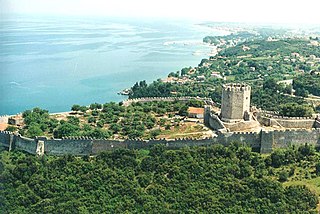The Kastro tis Orias (Greek : Κάστρο της Ωριάς, "Castle of the Fair Maiden") or Kastro tis Marous (Κάστρο της Μαρούς, "Castle of Maria") is a Greek ballad about a fair maiden who fell from the battlements of her castle to her death when it was taken by an enemy, typically Saracens or Ottomans. In many versions, it has been known throughout the Greek world since the Middle Ages. The name has been applied to many fortifications across the Greek world (cf. Kastro tis Orias).

Greek is an independent branch of the Indo-European family of languages, native to Greece, Cyprus and other parts of the Eastern Mediterranean and the Black Sea. It has the longest documented history of any living Indo-European language, spanning more than 3000 years of written records. Its writing system has been the Greek alphabet for the major part of its history; other systems, such as Linear B and the Cypriot syllabary, were used previously. The alphabet arose from the Phoenician script and was in turn the basis of the Latin, Cyrillic, Armenian, Coptic, Gothic, and many other writing systems.
The Greeks or Hellenes are an ethnic group native to Greece, Cyprus, southern Albania, Italy, Turkey, Egypt and, to a lesser extent, other countries surrounding the Mediterranean Sea. They also form a significant diaspora, with Greek communities established around the world.

A ballad is a form of verse, often a narrative set to music. Ballads derive from the medieval French chanson balladée or ballade, which were originally "danced songs". Ballads were particularly characteristic of the popular poetry and song of Ireland and Britain from the later medieval period until the 19th century. They were widely used across Europe, and later in Australia, North Africa, North America and South America. Ballads are often 13 lines with an ABABBCBC form, consisting of couplets of rhymed verse, each of 14 syllables. Another common form is ABAB or ABCB repeated, in alternating 8 and 6 syllable lines.
The ballad may originally have been based on the Sack of Amorium (838); the characteristics of the citadel of Amorium (near modern Emirdağ, Turkey) seem to be mentioned, especially in the version called "To Kastro tis Marous". [1]

The Sack of Amorium by the Abbasid Caliphate in mid-August 838 was one of the major events in the long history of the Arab–Byzantine Wars. The Abbasid campaign was led personally by the Caliph al-Mu'tasim, in retaliation to a virtually unopposed expedition launched by the Byzantine emperor Theophilos into the Caliphate's borderlands the previous year. Mu'tasim targeted Amorium, a Byzantine city in western Asia Minor, because it was the birthplace of the ruling Byzantine dynasty and, at the time, one of Byzantium's largest and most important cities. The caliph gathered an exceptionally large army, which he divided in two parts, which invaded from the northeast and the south. The northeastern army defeated the Byzantine forces under Theophilos at Anzen, allowing the Abbasids to penetrate deep into Byzantine-held Asia Minor and converge upon Ancyra, which they found abandoned. After sacking the city, they turned south to Amorium, where they arrived on 1 August. Faced with intrigues at Constantinople and the rebellion of the large Khurramite contingent of his army, Theophilos was unable to aid the city.

Amorium was a city in Phrygia, Asia Minor which was founded in the Hellenistic period, flourished under the Byzantine Empire, and declined after the Arab sack of 838. It was situated on the Byzantine military road from Constantinople to Cilicia. Its ruins and höyük are located under and around the modern village of Hisarköy, 13 kilometers east of the district center, Emirdağ, Afyonkarahisar Province, Turkey.

Emirdağ is a town and district of Afyonkarahisar Province in Turkey, between the city of Afyon and Eskişehir. The district covers an area of 2,009 km², and the population (2014) is 38,269 of which 19,093 live in the town of Emirdağ itself. The mayor is Cengiz Pala (AKP).









